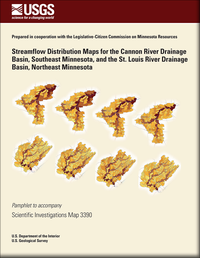Streamflow distribution maps for the Cannon River drainage basin, southeast Minnesota, and the St. Louis River drainage basin, northeast Minnesota
Links
- Document: Pamphlet (976 kB pdf)
- Sheets:
- Data Releases:
- USGS data release - Soil-Water-Balance model data sets for the Cannon River drainage basin, southeast Minnesota, 1995-2010
- USGS data release - Soil-Water-Balance model data sets for the St. Louis River drainage basin, northeast Minnesota, 1995-2010
- Download citation as: RIS | Dublin Core
Abstract
Streamflow distribution maps for the Cannon River and St. Louis River drainage basins were developed by the U.S. Geological Survey, in cooperation with the Legislative-Citizen Commission on Minnesota Resources, to illustrate relative and cumulative streamflow distributions. The Cannon River was selected to provide baseline data to assess the effects of potential surficial sand mining, and the St. Louis River was selected to determine the effects of ongoing Mesabi Iron Range mining. Each drainage basin (Cannon, St. Louis) was subdivided into nested drainage basins: the Cannon River was subdivided into 152 nested drainage basins, and the St. Louis River was subdivided into 353 nested drainage basins. For each smaller drainage basin, the estimated volumes of groundwater discharge (as base flow) and surface runoff flowing into all surface-water features were displayed under the following conditions: (1) extreme low-flow conditions, comparable to an exceedance-probability quantile of 0.95; (2) low-flow conditions, comparable to an exceedance-probability quantile of 0.90; (3) a median condition, comparable to an exceedance-probability quantile of 0.50; and (4) a high-flow condition, comparable to an exceedance-probability quantile of 0.02.
Streamflow distribution maps were developed using flow-duration curve exceedance-probability quantiles in conjunction with Soil-Water-Balance model outputs; both the flow-duration curve and Soil-Water-Balance models were built upon previously published U.S. Geological Survey reports. The selected streamflow distribution maps provide a proactive water management tool for State cooperators by illustrating flow rates during a range of hydraulic conditions. Furthermore, after the nested drainage basins are highlighted in terms of surface-water flows, the streamflows can be evaluated in the context of meeting specific ecological flows under different flow regimes and potentially assist with decisions regarding groundwater and surface-water appropriations. Presented streamflow distribution maps are foundational work intended to support the development of additional streamflow distribution maps that include statistical constraints on the selected flow conditions.
Suggested Citation
Smith, E.A., Sanocki, C.A., Lorenz, D.L., and Jacobsen, K.E., 2017, Streamflow distribution maps for the Cannon River drainage basin, southeast Minnesota, and the St. Louis River drainage basin, northeast Minnesota: U.S. Geological Survey Scientific Investigations Map 3390, pamphlet 16 p., 2 sheets, https://doi.org/10.3133/sim3390.
ISSN: 2329-132X (online)
Study Area
Table of Contents
- Acknowledgments
- Abstract
- Introduction
- Streamflow Distribution Maps
- Summary
- References Cited
| Publication type | Report |
|---|---|
| Publication Subtype | USGS Numbered Series |
| Title | Streamflow distribution maps for the Cannon River drainage basin, southeast Minnesota, and the St. Louis River drainage basin, northeast Minnesota |
| Series title | Scientific Investigations Map |
| Series number | 3390 |
| DOI | 10.3133/sim3390 |
| Publication Date | December 27, 2017 |
| Year Published | 2017 |
| Language | English |
| Publisher | U.S. Geological Survey |
| Publisher location | Reston, VA |
| Contributing office(s) | Minnesota Water Science Center |
| Description | Pamphlet: vii, 16 p.; 2 Sheets: 22.0 inches x 11.0 inches; Data Releases |
| Country | United States |
| State | Minnesota |
| Other Geospatial | Cannon River Drainage Basin, St. Louis River Drainage Basin |
| Online Only (Y/N) | Y |
| Additional Online Files (Y/N) | Y |


